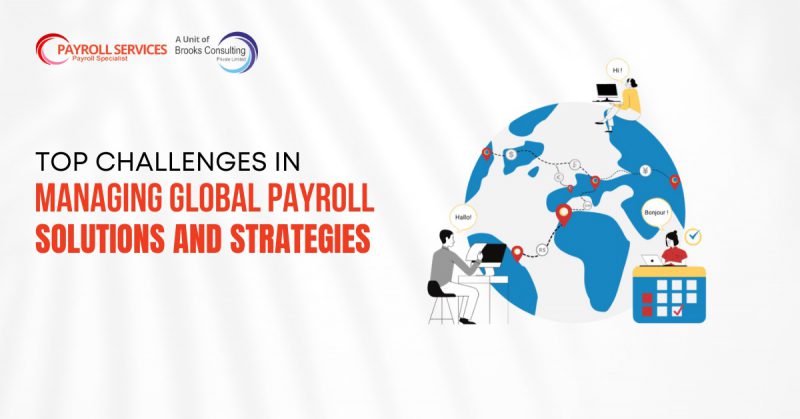Top Challenges in Managing Global Payroll: Solutions and Strategies
Managing global payroll is one of the most complex tasks for multinational organizations due to varying tax regulations, currency fluctuations, compliance requirements, and employee expectations. The complexity is amplified when companies operate across countries with distinct labor laws, financial systems, and cultural expectations. This article explores the top challenges in managing global payroll, along with effective solutions and strategies to streamline the process.
1. Navigating Complex Compliance Requirements
Challenge: Every country has its own tax laws, labor regulations, social contributions, and reporting standards. Staying compliant across multiple jurisdictions can be challenging, especially with frequent changes in local regulations. Non-compliance can lead to costly penalties, legal issues, and reputational damage.
Solution and Strategy:
- Invest in a Global Payroll System: Utilize payroll software that offers real-time updates on tax codes, social security contributions, and other local compliance needs.
- Partner with Local Experts: Collaborating with local payroll specialists ensures you remain up-to-date with local regulations.
- Conduct Regular Compliance Audits: Periodic audits help identify compliance gaps and ensure adherence to local laws.
2. Handling Currency and Exchange Rate Fluctuations
Challenge: Managing payroll across different currencies exposes businesses to currency exchange risks, which can impact budgets and payroll accuracy. Exchange rate fluctuations may lead to unexpected expenses and challenges in maintaining consistent payroll.
Solution and Strategy:
- Use Multi-Currency Payroll Software: Choose a payroll system that supports multi-currency payments to minimize exchange-related discrepancies.
- Adopt Currency Hedging Strategies: Financial hedging strategies can reduce exposure to currency fluctuations, helping stabilize payroll costs.
- Automate Conversion Updates: Ensuring your payroll software auto-updates with current exchange rates helps maintain payroll accuracy.
3. Ensuring Data Security and Privacy Compliance
Challenge: Managing sensitive employee data across borders exposes organizations to data privacy and security risks. Each region has unique data protection laws, such as the GDPR in Europe, making it difficult to maintain global consistency while ensuring local compliance.
Solution and Strategy:
- Use Secure Payroll Platforms with Global Data Compliance: Select a payroll system compliant with data privacy regulations like GDPR and implement multi-layered security measures, such as encryption and secure access protocols.
- Implement Role-Based Access Controls (RBAC): Limiting data access to specific roles helps reduce the risk of data breaches.
- Conduct Regular Security Audits: Consistent monitoring and assessment of security practices can identify vulnerabilities early and ensure compliance with global data privacy standards.
4. Dealing with Varied Payment Schedules and Payroll Cycles
Challenge: Different countries may have different payment schedules, making it difficult for HR departments to synchronize payroll cycles globally. The lack of standardization can lead to discrepancies, errors, and employee dissatisfaction.
Solution and Strategy:
- Standardize Payroll Processes Where Possible: Establish global payroll guidelines, while allowing flexibility for country-specific schedules.
- Implement a Centralized Payroll Management System: A single platform that can manage various pay cycles makes it easier to track and manage payroll.
- Use a Hybrid Payroll Model: A combination of centralized oversight with decentralized execution in regions that need specific payroll cycles can ensure timeliness and accuracy.
5. Managing Workforce Diversity and Localization Needs
Challenge: Employee expectations around compensation, benefits, and perks vary widely across regions. Ensuring local competitiveness while maintaining equity and alignment with global payroll standards can be challenging.
Solution and Strategy:
- Localize Payroll and Benefits Packages: Adapt payroll and benefits to reflect regional standards while aligning with your global compensation strategy.
- Establish Clear Communication Channels: Keep employees informed about payroll details, benefits, and any changes to avoid misunderstandings and build trust.
- Regularly Review Market Standards: Conducting periodic benchmarking against local standards can ensure competitive compensation and attract top talent.
6. Overcoming Technology Integration Challenges
Challenge: A common hurdle in global payroll management is integrating payroll systems with other HR, finance, and ERP systems. Without seamless integration, data silos and errors are more likely, leading to inefficiencies.
Solution and Strategy:
- Invest in Payroll Systems with API Integration: Modern payroll systems with open APIs allow for better data flow between systems, improving accuracy and efficiency.
- Standardize Technology Platforms: Standardizing technology across regions where possible ensures a smoother integration process.
- Prioritize Employee Self-Service Portals: Self-service platforms reduce administrative burden, allowing employees to access payroll information independently and keep personal data updated.
7. Tracking and Managing Payroll Costs Accurately
Challenge: Tracking payroll costs in multiple currencies, across different countries, and under various compensation structures can lead to financial inconsistencies, making budget management challenging.
Solution and Strategy:
- Use Real-Time Reporting and Analytics Tools: Payroll systems with robust analytics provide real-time insights into costs, helping you stay within budget and make informed financial decisions.
- Implement Predictive Payroll Forecasting: Using predictive analytics to forecast payroll expenses helps with budget planning and reduces financial risks associated with payroll.
- Conduct Regular Cost Analysis: Periodic reviews of payroll costs by country and currency allow for better allocation of resources and cost management.
8. Maintaining Employee Satisfaction and Engagement
Challenge: Errors or delays in payroll can significantly impact employee morale and satisfaction. Variations in benefits, tax deductions, and payroll policies can create friction if not managed properly.
Solution and Strategy:
- Ensure Timely and Accurate Payroll Processing: Automation can significantly reduce errors, and investing in reliable payroll software minimizes the risk of delayed payments.
- Provide Consistent Communication and Support: Keeping employees informed about payroll-related changes fosters trust and helps manage expectations.
- Offer Transparent Payroll Processes: Providing clear payroll breakdowns and implementing employee self-service options allows employees to understand deductions, benefits, and other payroll details.
Conclusion
Managing global payroll involves navigating a maze of compliance requirements, technology integration, data privacy, and employee expectations. With the right strategies—such as investing in robust, flexible payroll software, maintaining up-to-date compliance, and establishing clear communication channels—businesses can simplify and streamline global payroll operations. Effective global payroll management not only enhances operational efficiency but also fosters trust, satisfaction, and compliance within a diverse workforce, ensuring that the organization remains competitive and resilient in an increasingly globalized world.

